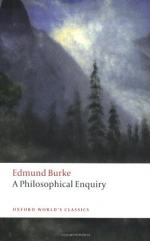
|
| Name: _________________________ | Period: ___________________ |
This test consists of 5 short answer questions, 10 short essay questions, and 1 (of 3) essay topics.
Short Answer Questions
1. How should the eye move, in order to qualify as beautiful, according to Burke?
2. What causes hearing in humans, according to Burke?
3. How do use and habit affect pleasure?
4. Which does Burke's definition of "grace" include?
5. According to Burke, what is the mechanical reason darkness is terrible?
Short Essay Questions
1. What types of sounds, smells, and tastes can be considered beautiful, according to Burke?
2. How does Burke define ugliness, and how does Burke relate ugliness to beauty?
3. In his discussion of proportionality among human figures, what censure does Burke lay upon advocates proportion-as-beauty?
4. Paraphrase Burke's definition of beauty and the distinction he makes between love and lust or desire.
5. How does Burke use women as examples to demonstrate some of the aspects of beauty?
6. To what effect does Burke use the example of Campanella?
7. What, according to Burke, is the primary strength of poetry?
8. What is the "real" cause of beauty, according to Burke?
9. What two examples does Burke use to illustrate the sublimity of succession in visual objects? Upon which principles does Burke assert these two examples operate?
10. What does Burke identify as the three effects of words?
Essay Topics
Write an essay for ONE of the following topics:
Essay Topic 1
Summarize Burke's definition of pain and pleasure. How do they exist relative to one another? How do they influence human passions? What state of being does one occupy when experiencing neither pain nor pleasure? How does Burke distinguish delight from pleasure, and how does he connect joy and grief? What examples does Burke use to support his definitions?
Essay Topic 2
Summarize Locke's idea of the nature of darkness and Burke's idea of the nature of darkness. Where do they differ? Why does Burke think differently than Locke, and what examples does he use to support his opinion? How does darkness affect the body and the mind, according to Burke? Do you think the cultural associations we have with darkness (the general theme of it and the common things it symbolizes) can be relevant to our view of darkness, in addition to or instead of Burke's opinion of darkness' nature?
Essay Topic 3
Define obscurity and clearness, or clarity, as Burke uses them. What significance do obscurity and clearness have to the sublime? How does the imagination interact with obscurity and with clarity? Which passions does Burke associate with obscurity, and which with clarity? Define the aspects of dimensionality Burke uses (vastness, infinity, and magnitude). How do these relate to the sublime? What qualities of "magnificence" are sublime? Use examples like what Burke uses to support your points.
|
This section contains 1,080 words (approx. 4 pages at 300 words per page) |

|




